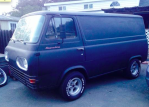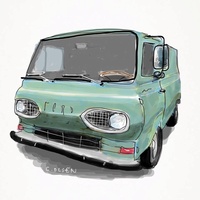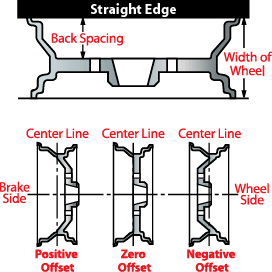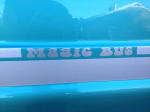me like 
+8
Seth G
Magic Bus
vanny
rehreh07
cali2chitown
larrytech1
61econoline
bugman
12 posters
1964 Ford Econoline New Rims and Tires

Devo- Number of posts : 32
Location : Pacific Grove, Ca
Registration date : 2014-06-09

bugman- Number of posts : 72
Location : connecticut
Registration date : 2011-12-17
I can fit my finger between the sidewall of the rear tire and the fender so the rear setup is as wide as I would go without rolling the fender. The front, because of the smaller tire size, is no issue at all.

Seth G- Vintage-Vans Listings Manager

- Number of posts : 2087
Location : Anacortes, WA
Age : 51
Registration date : 2013-04-24
Thanks alot for the info bugman! Really helps me out.

'fish- Number of posts : 222
Location : California
Registration date : 2011-12-27
If I remember from back in my wheel selling days at Super Shops here in southern California you have center then you have negative offset and positive offset, a 8 inch wheel with 4"of back space is a 0 offset where a 8 inch wheel with a 3" backspace would have a negative offset of 1" inversly a 8 inch heel with 5 inches of back space would have a positive offset of 1 inch, this is how you determine the distance from the hub to the suspension and then to the fender.
A simple method to do this is to jack up the car up, put it on a jack stand at the same ride height take off the wheel, at the front edge of the hub you have your centerline, the distance to the suspension is your backspace, the distance to your fender is the tolerance, so if your center line is say 6 inches from the suspension you wouldnt want anymore than 4.5 inches of backspace and this depends on how much side bulge you have in the tire.

What orignal poster is saying is the wheels he is running are at center with no offset on the 8inch wheel with 4 inches of backspacing. and the fronts are 7 inch with 4 inches of backspacing with a 1 inch positive offset.
The more negative offset you have the deeper the dish in on the front side of the wheel. and to a point the better the vehicle handles, positive offset is more for load carrying capability than handeling as evidenced by a duallys front wheels.
A simple method to do this is to jack up the car up, put it on a jack stand at the same ride height take off the wheel, at the front edge of the hub you have your centerline, the distance to the suspension is your backspace, the distance to your fender is the tolerance, so if your center line is say 6 inches from the suspension you wouldnt want anymore than 4.5 inches of backspace and this depends on how much side bulge you have in the tire.

What orignal poster is saying is the wheels he is running are at center with no offset on the 8inch wheel with 4 inches of backspacing. and the fronts are 7 inch with 4 inches of backspacing with a 1 inch positive offset.
The more negative offset you have the deeper the dish in on the front side of the wheel. and to a point the better the vehicle handles, positive offset is more for load carrying capability than handeling as evidenced by a duallys front wheels.

Magic Bus- Number of posts : 1422
Location : -Gateway to the West - St Louis Missouri
Registration date : 2009-12-02
Good info Fish, just remember that when measuring wheel width, you measure the inside part where the bead of the tire hits, so a 7" wheel might actually measure 7 3/4 to maybe 8" if measured on the outside. All this stuff really factors in when trying to max out the width w/o rubbing issues, not forgetting like you said the "bulge" of the tire because they don't go straight up and down. It would be nice if there were a formula or reference chart for the tire bulge calculation but Ive never seen one.

Seth G- Vintage-Vans Listings Manager

- Number of posts : 2087
Location : Anacortes, WA
Age : 51
Registration date : 2013-04-24
There is Magic Bus, its the section width, ie 195mm, this is the outside wall to wall widest part of the tire, read bulge. The aspect ratio, ie 60, is the percent of the section width, it determines the sidewall height. The tire will bulge beyond the section width at the bottom where the load meets the road, but we don't have rubbing issues there of course.
You can know the exact dimensions of any tire based upon it's listed measurement on the sidewall, in theory at least. A 195/60 R15 would be about 7.7"(195mm) wide and 24.25" tall(7.7 x .6 x 2 + 15) The amount of perceived "bulge" has everything to do with tire section width, aspect ratio and rim width combinations. But it should measure out to the listed section width on the sidewall regardless of the other factors.
http://www.discounttire.com/dtcs/infoTireDimensions.do
Fish, as Magic Bus mentioned that backspace info is close but incorrect. Rims have ~.5" extra on the backspace @ 0" offset b/c that includes the flange of the rim, steelies maybe less but most alloys seem to be .5". Whereas the listed width is inner width between the flanges. A 7" rim is actually 8" wide, so a backspace of 4" to the backside of the mounting plate is still the center of the rim, hence 0 offset. In other words, a 7" rim with 0 offset generally has a backspace of 4" not 3.5". An 8 has 4.5" and so on. That's why the Indy slot rim with -5mm(~1/4") offset has a listed backspace of 3.75" instead of 4".
Bugmans rims appear to be 0mm offset in the 7" fronts and -12mm in the 8" rears if they both have 4" backspace and .5" flanges.
You can know the exact dimensions of any tire based upon it's listed measurement on the sidewall, in theory at least. A 195/60 R15 would be about 7.7"(195mm) wide and 24.25" tall(7.7 x .6 x 2 + 15) The amount of perceived "bulge" has everything to do with tire section width, aspect ratio and rim width combinations. But it should measure out to the listed section width on the sidewall regardless of the other factors.
http://www.discounttire.com/dtcs/infoTireDimensions.do
Fish, as Magic Bus mentioned that backspace info is close but incorrect. Rims have ~.5" extra on the backspace @ 0" offset b/c that includes the flange of the rim, steelies maybe less but most alloys seem to be .5". Whereas the listed width is inner width between the flanges. A 7" rim is actually 8" wide, so a backspace of 4" to the backside of the mounting plate is still the center of the rim, hence 0 offset. In other words, a 7" rim with 0 offset generally has a backspace of 4" not 3.5". An 8 has 4.5" and so on. That's why the Indy slot rim with -5mm(~1/4") offset has a listed backspace of 3.75" instead of 4".
Bugmans rims appear to be 0mm offset in the 7" fronts and -12mm in the 8" rears if they both have 4" backspace and .5" flanges.

'fish- Number of posts : 222
Location : California
Registration date : 2011-12-27
The information given is done so in general terms its a guide on how to fit and space wheels each aplication is different, you cant just genralize that a wheel "might have" an back space of 3.75 if its -5mm aluminum wheels are different than steel wheels, flanges and hoops differe from one manifacture to another, and all of it depends on the type and size of tire you plan to put on the vehicle I just added that because there seemed to be confusion of terms.
There is a whole lot more to this if you plan on going fast because tires also grow, so again sorry if there was some confusion that was a guide to terms and a general idea of how to measure and fit a wheel in any vehicle each application is different, a stock suburban and a tubbed show car have very different tolerances and needs so you cant just generalize tolerance for wheels each application has to be fit and measured for its specific use.
Here is a specific guide on how to measure and fit wheels, and how most shops and installers do the caculations:
https://www.rsracing.com/tech-wheel.html
There is a whole lot more to this if you plan on going fast because tires also grow, so again sorry if there was some confusion that was a guide to terms and a general idea of how to measure and fit a wheel in any vehicle each application is different, a stock suburban and a tubbed show car have very different tolerances and needs so you cant just generalize tolerance for wheels each application has to be fit and measured for its specific use.
Here is a specific guide on how to measure and fit wheels, and how most shops and installers do the caculations:
https://www.rsracing.com/tech-wheel.html

Seth G- Vintage-Vans Listings Manager

- Number of posts : 2087
Location : Anacortes, WA
Age : 51
Registration date : 2013-04-24
"you cant just generalize that a wheel "might have" an back space of 3.75 if its -5mm "
We're talking old Econoline vans here, I think we certainly can generalize to a large extent and it's going to get you pretty close using .5", but as you say this can vary a bit. The mfr specs or better still, actual measurements of the rim and the van are what you have to rely on ultimately once a choice is made, esp if it might matter. In the instance with the Indy mag, the .5" flange assumption is within 5 hundredths of an inch, about 3/64" or equals 3.79685" backspace, of their listed spec of 3.75" backspace w/ -5mm offset and that's assuming that Indy isn't rounding down the backspace figure.
If bugman's steel rims are less than .5" @ the flange, say .375", then the front 7's have a small positive offset of around 3mm, and the rear 8's still have a negative offset of 9-10mm. Certainly possible, but the difference between that and using an assumption of a .5" flange when you don't have the specs is probably not enough to matter unless you're pushing the limits of what will fit. We're talking about an 1/8", within that tolerance it's still going to come down to tire size in the end.
We're talking old Econoline vans here, I think we certainly can generalize to a large extent and it's going to get you pretty close using .5", but as you say this can vary a bit. The mfr specs or better still, actual measurements of the rim and the van are what you have to rely on ultimately once a choice is made, esp if it might matter. In the instance with the Indy mag, the .5" flange assumption is within 5 hundredths of an inch, about 3/64" or equals 3.79685" backspace, of their listed spec of 3.75" backspace w/ -5mm offset and that's assuming that Indy isn't rounding down the backspace figure.
If bugman's steel rims are less than .5" @ the flange, say .375", then the front 7's have a small positive offset of around 3mm, and the rear 8's still have a negative offset of 9-10mm. Certainly possible, but the difference between that and using an assumption of a .5" flange when you don't have the specs is probably not enough to matter unless you're pushing the limits of what will fit. We're talking about an 1/8", within that tolerance it's still going to come down to tire size in the end.

FCC- Number of posts : 295
Location : Batavia, Ohio
Registration date : 2014-04-29
I think that wheel specs would be way easier to talk about in simply a plus or minus offset in MM. Which is the distance from the wheel center to the mounting surface.
My car has 15x7 wheels with a +25mm offset. Read 1" further under the car, or a mounting surface 1" closer the face of the wheel. (When shopping wheels, a positive offset can also referred to as 'ET'. The term ET originates from the German word 'Einpresstiefe' which translates as 'insertion depth'.)
The whole backspacing AND offset in the same sentence thing is really complicating and over explaining a simple measurement. Unfortunately, the manufactures in America have always spoken in back spacing, and are now trying to do both BS in inches, and offset in MM. that really makes peoples brians ache for no good reason.
And once there is a known spec that is right for our vans, say if 15 x 7 needs +5 (totally made that up as an example), And there is say... another 2 inches on each side of the mounted wheel to fill up if we wanted.. we can then figure that a 15x9 would have room to fit, but would need +30 for the mounting surface to remain in the exact same location inside the rim, leaving you then with 1" of clearance on each side of the wheel.
Wheel suppliers just need to standardize and talk in offset. It's a single measurement that gets the job done more accurately.

My car has 15x7 wheels with a +25mm offset. Read 1" further under the car, or a mounting surface 1" closer the face of the wheel. (When shopping wheels, a positive offset can also referred to as 'ET'. The term ET originates from the German word 'Einpresstiefe' which translates as 'insertion depth'.)
The whole backspacing AND offset in the same sentence thing is really complicating and over explaining a simple measurement. Unfortunately, the manufactures in America have always spoken in back spacing, and are now trying to do both BS in inches, and offset in MM. that really makes peoples brians ache for no good reason.
And once there is a known spec that is right for our vans, say if 15 x 7 needs +5 (totally made that up as an example), And there is say... another 2 inches on each side of the mounted wheel to fill up if we wanted.. we can then figure that a 15x9 would have room to fit, but would need +30 for the mounting surface to remain in the exact same location inside the rim, leaving you then with 1" of clearance on each side of the wheel.
Wheel suppliers just need to standardize and talk in offset. It's a single measurement that gets the job done more accurately.


Devo- Number of posts : 32
Location : Pacific Grove, Ca
Registration date : 2014-06-09
great pic!
every picture says a thousand words.
so i have a set of American Racing Equipment, torque thrust, aluminum, A7 x 14 x 1/2" positive offset with Firehawk Indy 500 P225/70R14
recently i picked up this '62 with the wheels on it, which i like, and don't intend on changing until the day comes when i have a V8 put in it.
every picture says a thousand words.
so i have a set of American Racing Equipment, torque thrust, aluminum, A7 x 14 x 1/2" positive offset with Firehawk Indy 500 P225/70R14
recently i picked up this '62 with the wheels on it, which i like, and don't intend on changing until the day comes when i have a V8 put in it.

FCC- Number of posts : 295
Location : Batavia, Ohio
Registration date : 2014-04-29
right. so 14X7 et12. And unless there happens to be something on the van in the way, you could run 15X7, 16x7, etc, with the same known good offset...
..which leads to another conversation. Does anyone know what diameter the stock tires were back in the day? My van had 185/70/13s on it. And from what I have found, that is about a 23.2" diameter.
If that be the diameter that I need to retain the 4.0:1 diff ratio and keep my speedometer accurate, then I need a 195/55/15 to be at about the same diameter.
Also, are there gears available for correcting the speedo when changing gears or tire sizes?
Old tire diameter/new tire diameter X diff ratio = Adjusted diff ratio
I am considering swapping to a 3.5:1 axle in the back, but buying 15x7s and running a 205/60/15 would get me a 3.75: adjusted ratio. I would just need a way to correct the speedo..
I found these 15x7s today... Pretty hot.

..which leads to another conversation. Does anyone know what diameter the stock tires were back in the day? My van had 185/70/13s on it. And from what I have found, that is about a 23.2" diameter.
If that be the diameter that I need to retain the 4.0:1 diff ratio and keep my speedometer accurate, then I need a 195/55/15 to be at about the same diameter.
Also, are there gears available for correcting the speedo when changing gears or tire sizes?
Old tire diameter/new tire diameter X diff ratio = Adjusted diff ratio
I am considering swapping to a 3.5:1 axle in the back, but buying 15x7s and running a 205/60/15 would get me a 3.75: adjusted ratio. I would just need a way to correct the speedo..
I found these 15x7s today... Pretty hot.


Seth G- Vintage-Vans Listings Manager

- Number of posts : 2087
Location : Anacortes, WA
Age : 51
Registration date : 2013-04-24
I don't know the original diameter but what is on my van now have a diameter of 25.5", 195/75 R14. And looking at other folks combo's this seems to be a common wheel diameter on these vans. I think larger is possible though within reason. As far as the offset vs backspace issue, I believe the reason both are listed is b/c of the variance in total rim width, rim size + flange width. I was lookiing at those wheels FCC, they're pretty cool. I think I've settled on polished American Racing VN109 TT O's, 7" x 15" w/ -6 offset sporting 225/60's on all 4 wheels. At least for the moment 

Although if I was going with 17's I'd be real tempted to go with the Black AR Blvd's


Although if I was going with 17's I'd be real tempted to go with the Black AR Blvd's


Seth G- Vintage-Vans Listings Manager

- Number of posts : 2087
Location : Anacortes, WA
Age : 51
Registration date : 2013-04-24
Magic Bus, I've found that there is a caveat to the section width rule b/c a tire can fit a range of rim widths. For the measurement to be true to the spec on the tire, the tire must be mounted on a rim of the same width as was used when measured by the tire maker i.e. 6", 7" so on, this is the measuring rim size. Otherwise, the rule of thumb is that the section width will increase or decrease .2" for every .5" change in rim width between the rim it's mounted to and the measuring rim. And that's the rest of the story as it goes and I think what you were looking for. I'm sure learning alot about tires 
http://www.tirerack.com/tires/tiretech/techpage.jsp?techid=198
http://www.tirerack.com/tires/tiretech/techpage.jsp?techid=198

gh0st- Number of posts : 50
Location : virginia
Registration date : 2011-07-25
If you come up with the measurement of the drum face / hub surface to the inner fender lip, then one could make use of this to resolve tire clearance issues:
http://www.jonathanrowny.com/page/offset-calculator
Obviously does not account for lock-to-lock interference of the front wheels, but does a great job assisting with wheel & tire selection, etc.
http://www.jonathanrowny.com/page/offset-calculator
Obviously does not account for lock-to-lock interference of the front wheels, but does a great job assisting with wheel & tire selection, etc.









